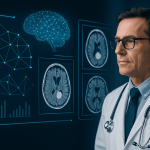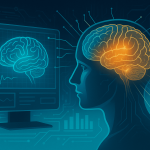
Federated Learning Technology in Medical Privacy AI
Federated learning technology is transforming how hospitals and research centers train AI systems on sensitive medical images. This innovation allows organizations to build powerful, accurate models without exposing private patient data. In an era defined by HIPAA and GDPR, it provides a crucial bridge between data privacy and AI performance.
By enabling local training on distributed datasets, federated learning technology empowers healthcare institutions to collaborate safely. Hospitals can now share knowledge not data and advance medical imaging intelligence while remaining compliant.
What Is Federated Learning Technology in Healthcare?
At its core, federated learning technology is a decentralized AI training method. Instead of pooling patient scans in a single data warehouse, hospitals train models locally. These models send encrypted updates not images to a central server that aggregates and refines a shared global model.
This framework is particularly suited for MRI, CT, and X-ray data, where privacy and scale matter equally. It allows medical professionals to leverage collective intelligence without the risks of traditional data sharing.
Google’s Overview of Federated Learning
How Federated Learning Technology Protects Patient Privacy
Patient images are among the most sensitive healthcare data. A single scan may expose identity, medical conditions, or genetic traits. Sharing such data even with anonymization poses risks of re-identification.
Through federated learning technology, data remains securely within each institution’s infrastructure. The system transmits only encrypted gradients and model updates. As a result, hospitals meet compliance standards, reduce breach exposure, and maintain patient confidence.
Healthcare CIOs find this especially valuable: it lowers regulatory risk while supporting AI progress.
Distributed Medical Data and Federated Learning Technology
Medical data fragmentation is a well-known issue. Hospitals, clinics, and research labs each hold partial datasets oncology here, cardiology there. Federated learning technology unites these silos without centralizing data.
Each site contributes its unique specialty rural clinics bring rare cases; large urban hospitals add volume and diversity. The aggregated AI model learns from all, producing improved diagnostic capabilities across disease types and demographics.
This inclusive approach democratizes healthcare AI development and ensures representation from diverse populations.
Real-World Examples of Federated Learning Technology
Across healthcare, federated learning technology already drives breakthroughs:
-
Brain Tumor Segmentation: Multiple hospitals jointly train MRI-based tumor detection models while keeping scans local.
-
Diabetic Retinopathy Screening: Eye clinics contribute insights globally; the AI detects early retinal damage while maintaining photo privacy.
-
COVID-19 Imaging Models: Global networks of hospitals collaborate on chest CT models to identify infection patterns without sharing data.
Benefits include:
-
Faster training on distributed systems
-
Improved generalization across demographics
-
Enhanced privacy and trust in AI adoption
Challenges of Federated Technology in Medical Imaging
Despite its advantages, federated learning technology faces obstacles. Network latency can slow communication between nodes, and varying hardware capacity across hospitals introduces inconsistencies. Furthermore, model drift occurs when local datasets differ significantly.
Solutions are emerging:
-
Differential Privacy: Adds statistical noise to safeguard contributions.
-
Secure Aggregation: Ensures individual hospital updates remain confidential.
Outbound Reference: NIH Study on Federated Learning in Imaging
With these techniques, healthcare AI becomes both collaborative and compliant.
Improving AI Accuracy with Federated Learning Technology
Traditional AI models often underperform due to limited or biased datasets. Federated learning technology overcomes this by integrating real-world diversity. A shared model trained across regions and populations yields more reliable, fair, and accurate predictions.
For example, a network of hospitals treating different age groups or disease stages helps the global AI detect subtle variations, reducing false positives and improving diagnostic precision. The outcome: smarter, more inclusive healthcare.
Top Frameworks for Federated Learning Technology in Healthcare
Healthcare IT teams now have access to several open-source frameworks for federated learning technology:
-
TensorFlow Federated (TFF): A Google-led framework for decentralized AI training.
-
PySyft: Adds strong encryption and privacy layers.
-
NVIDIA FLARE: Designed specifically for medical and clinical collaboration.
Steps to get started:
-
Define your medical imaging task (e.g., pneumonia detection).
-
Deploy local training environments.
-
Implement secure model aggregation.
-
Validate and refine the global model collaboratively.
By starting with small-scale deployments, hospitals can scale as confidence and technical maturity grow.
Future of Federated Technology in Medical Visualization
As computing power grows, federated learning technology will extend to the edge. Imagine CT scanners and imaging devices performing on-site AI training. Updates synchronize securely overnight no raw data ever leaves the premises.
Regulatory bodies such as the European Commission increasingly favor privacy-preserving AI. This evolution aligns perfectly with federated learning technology, setting new global standards for ethical healthcare AI.
Soon, a connected network of hospitals worldwide could jointly train models for rare and complex diseases, unlocking breakthroughs faster and more safely.
Conclusion: The Promise of Federated Learning Technology
Federated technology bridges the gap between data privacy and AI innovation. Hospitals maintain ownership of patient information while benefiting from global intelligence. It represents a shift from isolated learning to cooperative advancement where privacy, ethics, and efficiency coexist.
For healthcare leaders, this isn’t just an IT upgrade it’s a trust-building transformation.
Explore our AI in Medical Imaging resource to learn more about implementing secure, distributed AI today.
FAQ on Federated Learning Technology
What is federated learning technology in healthcare?
It’s a decentralized AI training approach that allows hospitals to collaborate without exchanging patient data.
Does it reduce accuracy?
No. By including diverse data sources, federated learning technology improves model robustness and generalization.
Is it HIPAA-compliant?
Yes, as no identifiable data leaves the institution’s network.
Can small clinics participate?
Absolutely. Even limited datasets can enhance the collective intelligence.
What’s the biggest barrier?
Network reliability and technical coordination—but frameworks and secure protocols are closing these gaps.
Author Profile

- Online Media & PR Strategist
- Hello there! I'm Online Media & PR Strategist at NeticSpace | Passionate Journalist, Blogger, and SEO Specialist
Latest entries
 ColocationNovember 12, 2025Colocation Security Model Implementation
ColocationNovember 12, 2025Colocation Security Model Implementation Artificial InteligenceNovember 7, 2025SAP AI Strategy Enterprise Advances and Developer Tools
Artificial InteligenceNovember 7, 2025SAP AI Strategy Enterprise Advances and Developer Tools Scientific VisualizationOctober 29, 2025Federated Learning Technology in Medical Privacy AI
Scientific VisualizationOctober 29, 2025Federated Learning Technology in Medical Privacy AI Scientific VisualizationOctober 29, 2025Brain Visualization Ethics: Balancing Innovation and Privacy
Scientific VisualizationOctober 29, 2025Brain Visualization Ethics: Balancing Innovation and Privacy

